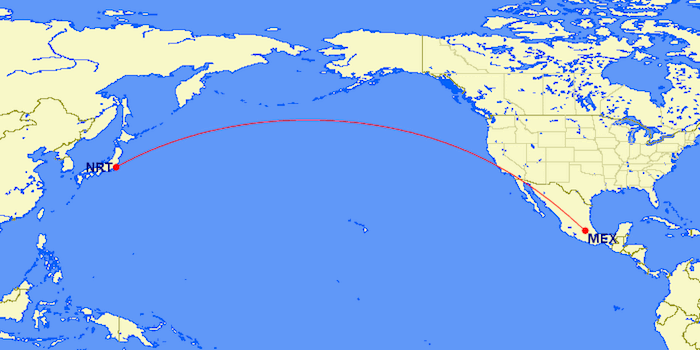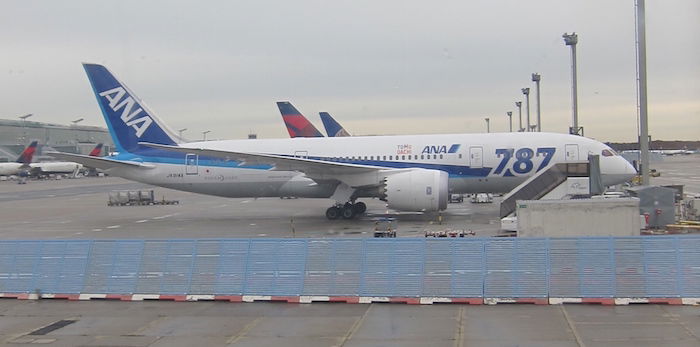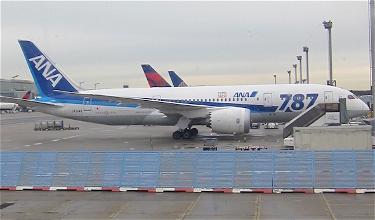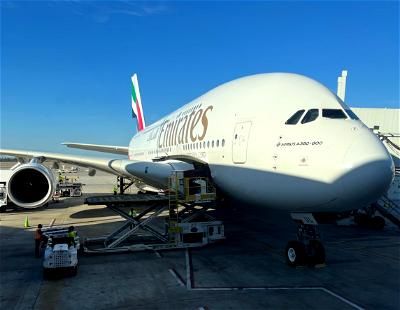Yesterday was an interesting day for new airline routes, as three airlines announced their longest flights yet:
- Emirates announced Dubai to Auckland, which will become the world’s longest route (Qatar Airways’ Doha to Auckland flight will be longer, if it ever launches, though we don’t know the specifics of it yet)
- United announced San Francisco to Singapore, which will become the airline’s longest route, and the only nonstop flight between the US and Singapore (at least until Singapore Airlines restarts nonstop service between the two countries in 2018)
And then there’s a third announcement — Japanese carrier All Nippon Airways announced they will launch daily nonstop flights between Mexico City and Tokyo Narita starting in the second half of 2016.

At 7,004 miles, this represents the airline’s longest route, beating out their 6,753 mile flight between Tokyo and Washington.
While the exact schedule hasn’t yet been announced, the flight will operate daily using a Boeing 787-8, which seems like a great fit for the route. ANA’s longhaul 787s are super low capacity, with just 169 seats, including 46 business class seats, 21 premium economy seats, and 102 economy seats.

The catch is that Mexico City Airport is at an altitude of ~7,300 feet, which could pose problems for operating the flight nonstop. Via Nikkei, ANA will consider limiting passenger numbers and cargo weight to cope until more efficient engines are available.

Presently Aeromexico is the only airline offering nonstop flights between Mexico and Japan, with their 4x weekly flights in the market. They also operate the flight with a 787. Back in the day the route was operated via Tijuana, but thanks to the operating performance of the 787, the route can be flown nonstop nowadays. It’s my understanding that it’s also sometimes weight restricted, though.
This is a great new option for passengers traveling between Japan and Mexico/Latin America. In June 2015, ANA launched flights between Tokyo and Houston, which were intended to provide easy connections to Latin America on their partner, United. This new route makes it even more practical to connect, given that doing an international-to-international connection in the US is a pain (you have to clear customs, as there’s no sterile international connection area).
Bottom line
This is a great time for the airline industry. When you combine low fuel prices with fuel efficient, (fairly) low capacity planes, some really cool new routes become possible, as we’ve seen. In the past airlines tried these routes with planes which were too large for the actual demand. When you combine that with high oil prices, it didn’t end well for the airlines.
Of course $100/barrel oil would change things a bit, but fundamentally planes like the Boeing 787 and Airbus A350 have made so many new routes feasible.
What do you make of ANA’s new route between Tokyo and Mexico City?





@M
That is incorrect. AM has been going non-stop now for the last few months...
@Owen
No sterile transit? Well there goes my Chinese theory
So probably a lot of South/Central American's going to Asia using the AM flight then since they have visa free access to Mexico?
Aeroméxico still doesn't fly nonstop MEX - NRT. It makes a stop at MTY on the outbound and flies nonstop on the inbound.
@Nick - Businesses are in business to make money, not to save the world. That is what drives their business decisions.
This is great news! Mexico is really coming into its own with a good economy and becoming a business destination as well! I really hope this works out for NH! They are a fantastic airline. I'll be flying F from IAH-NRT in a few weeks. Thanks to Lucky's blog I have redeemed amazing F experiences on NH and Etihad in June on their A380! I can't wait. Thank you Lucky!
Aeromexico last November announced it would increase its weekly flights to Tokyo (NRT) from 4x to 5x starting in April, so i guess its a good time to other the airlines to start operations in Mexico.
Mexicans will have the opportunity to choose another airline to fly directly to Tokio without make stop on the US, and compare the differences in price and services between ANA and Aeromexico.
"This new route makes it even more practical to connect, given that doing an international-to-international connection in the US is a pain (you have to clear customs, as there’s no sterile international connection area)."
MEX did away with sterile transit with the 2003-2005 terminal expansion. It was unfortunate to lose as the international gates had just been renovated in 1998 and were still quite sharp and pleasant. now every passenger has to pass immigration, USA...
"This new route makes it even more practical to connect, given that doing an international-to-international connection in the US is a pain (you have to clear customs, as there’s no sterile international connection area)."
MEX did away with sterile transit with the 2003-2005 terminal expansion. It was unfortunate to lose as the international gates had just been renovated in 1998 and were still quite sharp and pleasant. now every passenger has to pass immigration, USA style. Still, there's a lot more international capacity now and it's all filled so we apparently needed it.
The walkways to immigration are now a kilometer long and the hall is huge, though I'm usually through in fifteen minutes. Sometimes it can take as long as seventy or eighty minutes if I'm unlucky. That's all in T1, where ANA and all the *A airlines operate. SkyTeam airlines operate in T2 which is newer, but not more efficient.
We're supposed to be getting a new airport around 2020-2021 with new highways and subway lines to get us in and out faster. It's to be built on caissons and hung from cables like DIA, only instead of being hung over expansive soils it's to be hung over Lake Texcoco, which is dry except in the rainy season of very wet years. Even the runways will be suspended above the lake bed.
I hope sterile transit comes back and that ANA, AeroMexico, and lots of others like Copa and Avianca and American will be able to build hub connections through MEX with the new capacity. We do have 22 MM O&D pax to support the operators.
So the AM flights to NRT and PVG have been routinely charging US$500-800 more per round trip in Y than AC, UA, AA, and DL flights that connect in LAX, DFW, and YVR. That's a lot more to pay for a nonstop, but the AM flights actually did have a stop one way in TIJ until the 787 made the route viable without a refueling. The price difference is mostly for the benefit of avoiding USA immigration.
USA immigration is always dangerous and expensive for non-USA citizens and harassing for those who are citizens. Even transit passengers from most countries, including Mexico and China, require a visa and that visa takes months, extensive documentation, among the highest visa fees in the world, and in intrusive personal interview to get. That's just for transit because there is no sterile transit in the USA.
The USA also recognizes no data privacy rules and customs can copy and keep laptop contents so passengers with information about trade secrets or personal medical records or any kind of data that can't be published openly should erase their computers and eliminate any smartphone apps that could connect to email accounts before passing through USA customs.
Every visit to the USA carries the danger of visas being cancelled also at the discretion of any officer. Every visit includes a certain risk that it will be a passenger's last if the CBP officer is having a bad day.
So it's worth a lot to avoid passing through the USA. I'm surprised it took so long for a competitor to want to share AM's revenue here.
@Rico, there are flights to San Salvador, Bógota, Lima, Medellín and Panama City from MEX with Avianca and Copa Airlines
This may be a dumb question or I might be missing something but if ANA is aiming at Latin American transfer passengers it may be at a disadvantage at MEX since Aeromexico also flies to NRT and MEX is their hub. So wouldn't it be more beneficial for ANA to fly to, say, PTY and connect passengers with Copa flights?
Am I the only one that sees it a somewhat ironic that a few weeks/months after major climate talks a bunch of major airlines launch some of the most climate change unfriendly flights possible... These flights emit several tons of carbon per passenger. Good luck with limiting carbon emissions...
@No Name @askmrlee
I was referring to an operational fuel stop and not a stop onload/offload pax or cargo only for fuel. This happens often over the Pacific with a stop in ANC or over the Atlantic with a stop in Canada, Ireland, or Iceland (especially in the summer on UAs 757s) for fuel and does not require or even allow the pax to disembark, with the high cargo yields I am guessing they are...
@No Name @askmrlee
I was referring to an operational fuel stop and not a stop onload/offload pax or cargo only for fuel. This happens often over the Pacific with a stop in ANC or over the Atlantic with a stop in Canada, Ireland, or Iceland (especially in the summer on UAs 757s) for fuel and does not require or even allow the pax to disembark, with the high cargo yields I am guessing they are expecting on this route could very well allow for an operational stop.
Please someone correct me if I am wrong.
Looks like TPP in action. Who would have thought there would be so many Mexicans hanging out with the Japanese.
@Brad B It's a HUGE advantage to NOT have to stop in the US. I remember taking the PPT-LAX flight on TN which continued to CDG and those who continued on had to get off the plane and clear customs or immigration or some other crap, even if they were just transiting.
Didn't JAL or KAL use to operate a flight from NRT-LAX-GIG or SEL-LAX-GIG but then stopped because of immigration and other transit hassles?
This route would survive $100/barrel oil, at that price Brazil would be humming again.
So add an 5 freedom route to Brazil with it's large Japanese community and keep on flying.
@Brad B
Stopping in the US would break this route, it's all about not having to go true US immigration.
Would not be surprised if quite a few of the passengers are nationalities that would need a visa to enter the US that have business in South America, especially Chinese. But also other nations in South east Asia that is not visa waiver countries.
Even if it is weight restricted I see this as a positive for NH as I am sure this would be a cargo heavy route. It will be interesting to see if they choose to weight restrict it or have a fuel stop as a fuel stop in LAX would add exactly 0 miles (if they take the GC route) or my preferred fuel stop for this would be SJC which would be just 7,005mi,...
Even if it is weight restricted I see this as a positive for NH as I am sure this would be a cargo heavy route. It will be interesting to see if they choose to weight restrict it or have a fuel stop as a fuel stop in LAX would add exactly 0 miles (if they take the GC route) or my preferred fuel stop for this would be SJC which would be just 7,005mi, 1 additional mile, it would be a easy in and out airport, they already have a flight from there so they have the infrastructure and resources necessary to fuel it and it would avoid SFO or LAX delays.
Hey Ben, don't mean to nitpick but I believe that their IAD flight is their longest route :)
@ kq747 -- Great catch, thanks!
Mexico city is a high and hot city. The high altitude takes away oxygen so the engines have less power. Hot air is less dense so the engine makes less power. Many high and hot airports have very long runways to help offset the lack of power
@Andrew T -- Simply put, the engines cannot perform as well at high altitudes, as is the case in Denver, among others.
@ Andrew T - Higher altitude = lower density = lower lift = lower ability to climb = lower weight aircraft can carry. Other examples include Denver and Johannesburg.
@Andrew T, thinner air at higher altitude means there's less lift available during take-off. The plane will run out of runway before achieving the necessary airflow over the wings to generate the lift needed to get the plane off the ground.
This plays into performance restrictions at airports that are considered "hot and/or high" such as DXB during the daytime, JNB due to heat and altitude, MEX due to altitude, DEN due to altitude,...
@Andrew T, thinner air at higher altitude means there's less lift available during take-off. The plane will run out of runway before achieving the necessary airflow over the wings to generate the lift needed to get the plane off the ground.
This plays into performance restrictions at airports that are considered "hot and/or high" such as DXB during the daytime, JNB due to heat and altitude, MEX due to altitude, DEN due to altitude, and so on. That's why often you see planes that are relatively overpowered - the 777-200LR being a great example - operating these routes as they have spare lift and power to ensure sufficient margins.
Wait Aeromexico flies this right?
Curious, why exactly does altitude mean potentially having to limit the weight of the aircraft?
"This is a great time for the airline industry. When you combine low fuel prices with fuel efficient, (fairly) low capacity planes, some really cool new routes become possible, as we’ve seen. In the past airlines tried these routes with planes which were too large for the actual demand. When you combine that with high oil prices, it didn’t end well for the airlines.
Of course $100/barrel oil would change things a bit, but fundamentally...
"This is a great time for the airline industry. When you combine low fuel prices with fuel efficient, (fairly) low capacity planes, some really cool new routes become possible, as we’ve seen. In the past airlines tried these routes with planes which were too large for the actual demand. When you combine that with high oil prices, it didn’t end well for the airlines.
Of course $100/barrel oil would change things a bit, but fundamentally planes like the Boeing 787 and Airbus A350 have made so many new routes feasible. "
I think we have the same thing on our minds here.